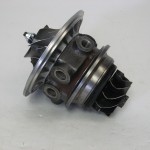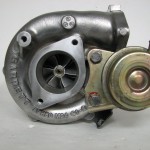Today we started a new project. Customer submitted a Hyundai Genesis Coupe Theta 2.0T engine for us to disassemble, assess build quality, and suggest upgraded parts for increased performance and reliability.
Initial observations: the new engine is an all aluminum inline 4. The block is lighter than the old 4G63. Contrary to the old 4G63 found in the Lancer Evolution 7-9, the new engine has the exhaust/turbo on the left side and intake on the right side of the engine. New engine uses bucket-style direct valve activation, compared to the 4G63 using rocker arms. Oil pump is not a separate unit driven by a chain off the crankshaft and located in the oil pan. 4G63 oil pump was timing belt driven and located in the front engine cover. 4B11 does not have balance shafts like its predecessor. Crankshaft is forged and fully counter-weighed. Pistons are cast with friction coated short piston skirts. Connecting rods are “broken” or fracture style. This means the connecting rod is made of powder steel as one piece and precise “broken” during manufacturing in order to separate it. We this being the weak point of the engine. While being adequate for its designed performance duties, the rods become a weak link when increasing engine performance. This can lead to catastrophic engine failures. Our suggestion is replacement of connecting rods in all performance-oriented applications. Main caps are independent on the 4b11 contrary to the 4G63 which has a single cast-iron girdle. Before disassembly we though the engine had the upper oil pan and main caps act as one unit, common practice in racing and even modern engines such as the F20 in the Honda S2000, but this was not the case. The main caps are not tied into the oil pan, nor are they connected together with any type of girdle. This is an area of development we will take on at Pavel’s Racing Engines.
Shortly we will be performing further disassembly of the cylinder head and testing valve springs. We will also provide all component dimensions and weights.
Enjoy the pictures. Most pictures have descriptions. Click to see the details.

























